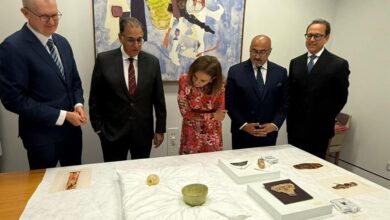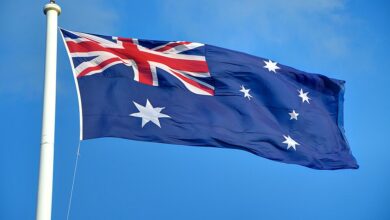
When Fred Brophy bangs a drum on the floodlit stage outside his boxing tent, the large crowd gathered in front of him falls silent in rapt attention.
Sporting a cowboy hat and a silky bright-red shirt, the tall and weathered 67-year-old looks every bit the showman.
Brophy runs a boxing troupe — the last in Australia and one of the few left worldwide — travelling to outback towns where someone’s always up for a fight.
“I’ve been doing it since I’ve been five years of age. I was born into it,” Brophy tells AFP in a broad Australian accent in Birdsville, a remote town in the vast continent’s dry, dusty interior, around 1,500 kilometers (900 miles) west of Brisbane.
Having his own troupe is something of a family tradition, he explains.
“Me father had one. Me grandfather had one. Me great-grandfather had one. So I’ve got one.”
Brophy and his touring pugilists are on their annual pilgrimage to the Queensland outback spot where more than 6,000 people travel for days and weeks across Australia to attend the centuries-old two-day Birdsville Races.
Racegoers, clutching beer cans while buffeted by dust and flies during the day, flock to Brophy’s big tent at night, eager for more action.
Lords of the ring
Back in the 1930s to 1950s, such tents were a fixture at country fairs and agricultural shows in the major cities, says Australian boxing author Grantlee Kieza.
It gave aspiring boxers, particularly those from poor backgrounds, a chance to hone their skills in front of intimate yet boisterous crowds, pocket some money, and become the hometown hero.
The troupes provided a foundation for some top Aboriginal boxers including Jack Hassen, George Bracken and Tony Mundine.
One of the best-known tents was Jimmy Sharman’s troupe, which attracted young indigenous boys keen to earn some cash.
But other forms of entertainment have since seduced spectators away from the ring.
“The great traditions of being outdoors on the frontiers of Australia changed to a more bohemian way I guess, and those sorts of manly rough sports began to decline in popularity,” author Kieza tells AFP.
Health and safety concerns led most states and territories to ban the travelling show, apart from Queensland and the Northern Territory.
Brophy has refused to throw in the towel, and his endangered status has meant his show attracts many fans and brawler wannabes when he visits the Queensland countryside, drum in hand.
Boxing’s ‘Wild West’
“It’s sort of like a carryover from the Wild Wild West days, isn’t it, the idea of tent boxing. It suits the Wild West image of rural Queensland,” Kieza says.
Brophy for one is happy to play up the image of the knockabout Australian outback maverick, immortalized in the “Crocodile Dundee” Hollywood films.
He says he’s been wounded by a shotgun, had his fingers cut off and his teeth knocked out, but keeps going.
“It’s 100 percent Australian. This is what Australians do. This is our entertainment,” he tells AFP.
“If you’ve got a sheila who’s watching you, you fight better,” he adds, using a slang term for a woman. “You win the fight, you win the sheila.”
His tent is a political correctness-free zone. One Asian fighter is called Chopsticks. Another — not a small man — is named Tiny Tim.
Popular tunes like “Down Under” — “where women glow and men plunder” — are blasted through speakers, and cowboy hat-wearing spectators squeeze onto long benches pressed up against the canvas.
Anti-immigration politician Pauline Hanson is a recent Birdsville regular, and she was invited by Brophy to be the card girl this year to raucous cheers.
Irreverent spirit
And then there are “The Bitch” and “The Beaver”.
When then 25-year-old Brettlyn Neal put her hand up to fight one of Brophy’s female boxers nicknamed “The Bitch” in 2010, he was so impressed by her performance she was offered a job.
Neal took on the moniker “The Beaver” and now uses the visits to remote communities to help disadvantaged youth by promoting education and fitness.
Despite the tough image the tent serves up, its primary role remains entertainment, she says.
“The number one thing is to make sure we put on a show — whether the crowd is cheering or booing. Then we’ve done our job,” Neal tells AFP after two young women jointly challenged her, sending the packed tent into a frenzy.
For another challenger, Leonie Hurst, the fight was one experience she’d wanted to tick off on her bucket list.
In the irreverent spirit of the tent, Hurst wore a bright green floral T-shirt bearing an expletive-laden message while fighting “The Beaver”.
“It’s really cool to be a part of — very nerve-wracking though. You sort of get in the ring and forget everything you’ve ever been trained to do, but it was still awesome,” she told AFP.
“We’ll see about the headache tomorrow.”




